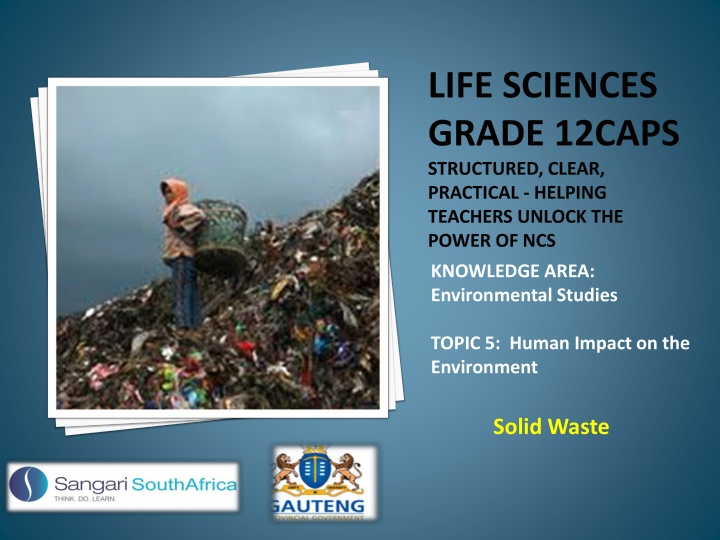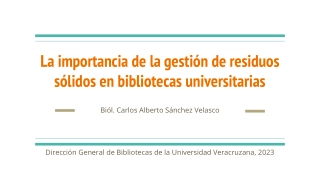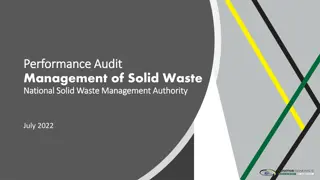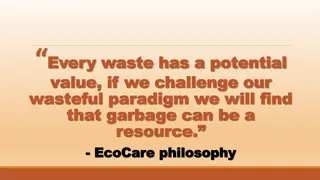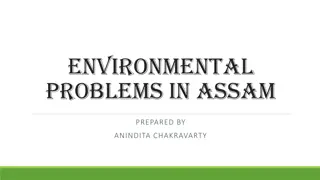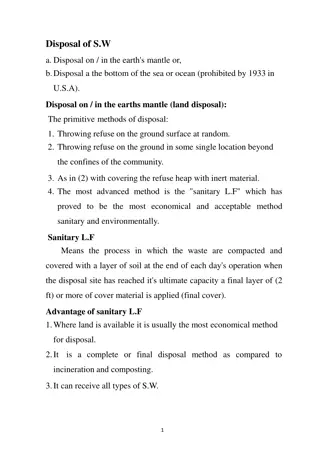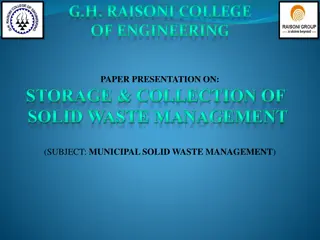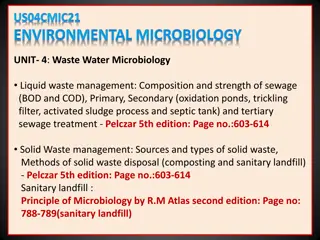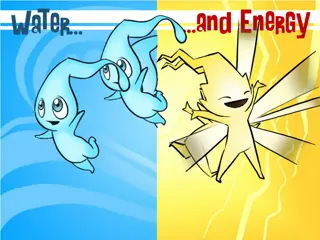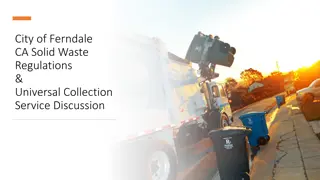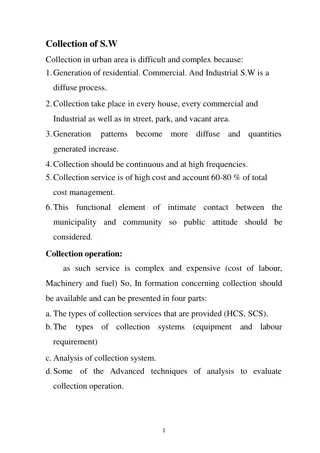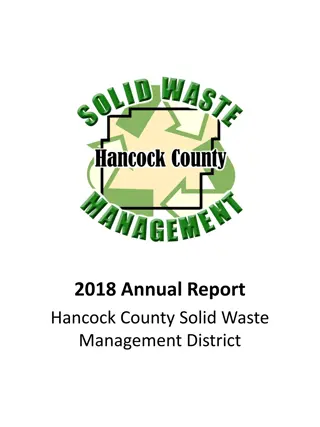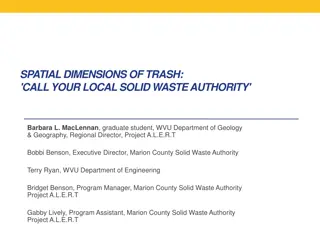Managing Solid Waste: Importance, Risks, and Solutions
Solid waste management is crucial to address environmental hazards such as disease spread, respiratory issues, and toxin release. By reducing and managing solid waste effectively, we can improve public health and prevent pollution of soil and water bodies. The presentation highlights reasons to minimize solid waste, dangers associated with improper disposal, and strategies for rehabilitating dumpsites and promoting recycling.
Download Presentation

Please find below an Image/Link to download the presentation.
The content on the website is provided AS IS for your information and personal use only. It may not be sold, licensed, or shared on other websites without obtaining consent from the author.If you encounter any issues during the download, it is possible that the publisher has removed the file from their server.
You are allowed to download the files provided on this website for personal or commercial use, subject to the condition that they are used lawfully. All files are the property of their respective owners.
The content on the website is provided AS IS for your information and personal use only. It may not be sold, licensed, or shared on other websites without obtaining consent from the author.
E N D
Presentation Transcript
LIFE SCIENCES GRADE 12CAPS STRUCTURED, CLEAR, PRACTICAL - HELPING TEACHERS UNLOCK THE POWER OF NCS KNOWLEDGE AREA: Environmental Studies TOPIC 5: Human Impact on the Environment Solid Waste
SUMMARY OF PRESENTATION: Solid waste: What is it? Reasons to Reduce or Manage Solid Waste Dangers Associated with Solid Waste Disposal Management of Dumpsites for Rehabilitation
SUMMARY OF PRESENTATION: Management of Dumpsites for the Prevention of Soil and Water pollution Use of Methane from Dumpsites The Need for Re-cycling Need for Safe Disposal of Nuclear Waste
SOLID WASTE: WHAT IS IT? Solid waste refers to non-hazardous industrial, commercial and domestic refuse. We must remember that solid waste does not include medical and hazardous industrial wastes. But in many countries these 2 parts are not separated from other solid waste.
REASONS TO REDUCE OR MANAGE SOLID WASTE We need to reduce or manage solid waste because it can lead to many problems. These are some of the problems
REASONS TO REDUCE OR MANAGE SOLID WASTE 1. The dumpsites have a lot of food and decaying food. Therefore many animals live in these dumpsites. Especially those that cause disease. Some examples are rats, flies and cockroaches. Disease-causing organisms
REASONS TO REDUCE OR MANAGE SOLID WASTE 2. Dust and unpleasant smells are released form the dumpsites. This can lead to many respiratory irritations and illness. It is also unpleasant to live in such conditions.
REASONS TO REDUCE OR MANAGE SOLID WASTE Some waste dumped by factories may undergo decomposition. 3. This many result in the release of many toxins into the air or soil. Only because it is decomposition of waste substance. From the soil these toxins can end up in the rivers, lakes and streams and even the aquifers.
REASONS TO REDUCE OR MANAGE SOLID WASTE 4. Greenhouse gases such as methane and carbon dioxide are released into the atmosphere, when the substances in the dumpsites are decomposed. Methane gas can explode resulting in serious injury and even death.
DANGERS ASSOCIATED WITH SOLID WASTE DISPOSAL Solid waste disposal as seen from the previous slides are dangerous or undesirable because It s a health hazard. a. It leads to unpleasant smells. b. It can cause explosions. c. It upsets the appearance of the area. d.
MANAGEMENT OF DUMPSITES FOR REHABILITATION Therefore it is necessary to manage or rehabilitatethese dumpsites. Rehabilitation refers to the process by which the environment is gradually restored to its normal condition after it has been partially or completely destroyed by pollution or other human activities.
TERMINOLOGY: TERM: Rehabilitation DEFINITION: USE IN SENTENCE: refers to the process by which the environment is gradually restored to its normal condition after it has been partially or completely destroyed by pollution or other human activities Rehabilitation can reverse water pollution.
MANAGEMENT OF DUMPSITES FOR REHABILITATION Rehabilitation has the following functions So that the dangerous toxins from soil and water pollutions are no longer present in the environment, and that The land that has been reclaimed can be used for recreational purposes such as sports fields and parks. a. b.
MANAGEMENT OF DUMPSITES FOR REHABILITATION Rehabilitation may be achieved in the following ways Cleaning up of the dumpsite. Use of plants to remove toxic gases from the atmosphere. Use of chemical to remove toxic chemicals found in the soil or water by way of chemical reactions. a. b. c.
MANAGEMENT OF DUMPSITES FOR THE PREVENTION OF SOIL AND WATER POLLUTION From the methods of rehabilitation listed in the previous slide we see that there are 2 ways in which soil and water pollution may be prevented. These are Phytoremediation Use of chemical reaction to remove toxins from the soil. Lets look at phytoremediation a. b.
MANAGEMENT OF DUMPSITES FOR THE PREVENTION OF SOIL AND WATER POLLUTION Phytoremediation a. Phytoremediation refers to the use of plants to remove toxins (poisonous chemicals ) from the soil. During phytoremediation toxins found in the soil, water or sediments are removed. These toxins are removed by the natural activities of the plant. These natural activities refer to the biological, chemical or physical activities of the plant.
TERMINOLOGY: TERM: Phytoremediation DEFINITION: USE IN SENTENCE: refers to the use of plants to remove toxins (poisonous chemicals ) from the soil. Phytoremediation can be used to remove the danger of water and soil pollution.
MANAGEMENT OF DUMPSITES FOR THE PREVENTION OF SOIL AND WATER POLLUTION It occurs in the following way Plants are planted in the dumpsites or polluted areas. The plants then absorb the toxins from the area. In some cases the plant roots release chemicals into the soil or water that detoxifies the soil or water. When the area has been rehabilitated then the plants are removed.
MANAGEMENT OF DUMPSITES FOR THE PREVENTION OF SOIL AND WATER POLLUTION Here are some examples for such plants Hydrangeas draw aluminum out of the soil. Hydrangeas
MANAGEMENT OF DUMPSITES FOR THE PREVENTION OF SOIL AND WATER POLLUTION Water hyssop removes lead, mercury, cadmium and chromium from bogs and wetlands. Water hyssop
MANAGEMENT OF DUMPSITES FOR THE PREVENTION OF SOIL AND WATER POLLUTION Water Hyacinth naturally absorbs pollutants from water, including cadmium, chromium, mercury, lead, zinc, cesium, strontium-90, uranium, and pesticides. But remember in South Africa this plant is an alien species. Water Hyacinth
USE OF METHANE FROM DUMPSITES The high temperatures and high water content in the dumpsites favours anaerobic respiration. The anaerobicbacteria thrive in these conditions. During anaerobic respiration methane is released as a by-product. Methane gas has some useful uses. These are.. It can be used to generate electricity. It can be used to cook and heat water. This is already in use in Durban.
THE NEED FOR RE-CYCLING In order to produce less waste we should reduce, reuse and recycle. Reduce- do not buy products that have too much packaging. This creates unnecessary waste. Reuse- we must use items over and over again if possible. For example glass bottles can be used as storage containers or plastic bags can be used again. Recycle- refers to making products from materials that have been used before.
TERMINOLOGY TERM: Recycle DEFINITION: USE IN SENTENCE: refers to making products from materials that have been used before. Recycling enables us to use less energy to create products.
THE NEED FOR RE-CYCLING Recycling ensures that we do not have to make product using new materials. This means that less energy is used in the manufacturing process. Habitat destruction is avoided. In this way, less resources are used. There will be a reduction in the emission of green house gases (GHG). This means the climate change will slow down.
NEED FOR SAFE DISPOSAL OF NUCLEAR WASTE Nuclear energy is produced by nuclear reactors. During this process ceramic uranium dioxide is used as fuel. The ceramic dioxide occurs as pellets. Uranium is radioactive. During a nuclear reaction the uranium atom splits and energy is released. Nuclear waste is produced during this reaction. The nuclear waste is radioactive.
NEED FOR SAFE DISPOSAL OF NUCLEAR WASTE This nuclear waste is stored at reactor site. It is stored in water pools. The water absorbs any heat and protects the workers on site. It acts as a radiation shield. Water pools storing nuclear waste
NEED FOR SAFE DISPOSAL OF NUCLEAR WASTE Nuclear wastes can remain radioactive for many years. For this reason safe disposal is necessary. Nuclear waste disposal in South Africa is managed by the National radioactive waste disposal institute.
SOMETHING FOR YOU TO DO A school wants to manage the large amount of waste generated on a daily basis. They decide to recycle the waste. (a) Define recycling (b) Give TWO reasons why the recycling of waste is advantageous.
SOLUTION The process by which waste materials are treated in such a way that they can be used again/reused - To avoid over-exploitation of the limited natural resources - To save/raise money /(create jobs) - To reduce the amount of waste material/cleaner environment - Less energy used/ Reduce carbon footprint - Fewer landfill sites a) b)
SOMETHING FOR YOU TO DO Explain, with reasons, FOUR strategies you would use to manage solid waste if you were appointed as the head of the waste disposal division of your town/city. NOTE: NO marks will be awarded for answers in the form of flow charts or diagrams
SOLUTION Management strategies to manage solid waste Landfill and burning with energy recovery - Utilize the heat generated from the burning of landfill sites to generate electricity thus saving on the electricity bill - Investigate methods to collect and utilize methane gas as a fuel
SOLUTION Recovery and recycling - Encourage citizens of the city to put different types of waste into different waste containers/bins of different colours - Partnership with recycling companies for improved collection of different wastes - Fines for people that do not separate the waste into different bins - This could generate income and reduce the transport cost - Educate people to use organic waste for example to make compost which could fertilise soil, they can plant vegetables
SOLUTION Educate citizens and companies to reuse waste - Glass containers for milk, cold drinks and alcohol etc. - This will reduce the need to produce more of these items - thus saving energy and money Reducing waste - Charge/penalties people extra if they generate more waste to encourage citizens to manage waste more efficiently/renewable any
SOMETHING FOR YOU TO DO The following table shows the total amount of solid waste and the amount of recyclable material dumped in a South African city landfill site over a number of years YEAR TOTAL AMOUNT OF SOLID WASTE (MILLIONS OF TONS) AMOUNT OF RECYCLABLE MATERIAL IN SOLID WASTE (MILLIONS OF TONS) 2003 1,49 0,78 2004 1,59 0,82 2005 1,80 1,20 2006 1,93 1,30
SOMETHING FOR YOU TO DO Describe the general trend in the total amount of waste produced and the amount of recyclable materials dumped from 2003 to 2006. Explain TWO advantages of recycling. 1. 2.
SOLUTION Both the total amount of waste produced and the amount of recyclable material increased from 2003 to 2006 People collect and sell waste at buy-back centres and benefits therefore economically/creates own jobs - People who collect waste and take it to recycling depots contributes to sustainable use of materials - Recycling saves energy and therefore reduces the amount of energy used to make new products 1. 2.
SOMETHING FOR YOU TO DO The table below shows the composition of household waste from a community. TYPE OF WASTE PERCENTAGE COMPOSITION Organic matter TYPE OF WASTE PERCENTAGE COMPOSITION 30 Plastic 25 Paper 15 Glass and tin 10 Other 20 Draw a pie chart to represent the data in the table above. Show ALL working.
SOLUTION Calculations: Organic matter: 30/100 X 360 = 108 Plastic: 25/100 X 360 = 90 Paper: 15/100 X 360 = 54 Glass and tin: 10/100 X 360 = 36 Other: 20/100 X 360 = 72 Your teacher will now draw the pie chart for you
SOMETHING FOR YOU TO DO The disposal of solid wastes is a major problem in most cities in South Africa. Write a mini-essay to describe any TWO disadvantages in disposing of solid waste in landfill sites as well as TWO advantages and TWO disadvantages of solid waste disposal by means of burning (incineration).
SOLUTION: Disadvantages in disposal of solid waste in landfill sites The wastes in a landfill attract vermin (rats, cockroaches etc) and these often harbour disease vectors Landfills give off bad odours /are ugly/presence leads to urban decay because only poor people are prepared to live near them Wind blown litter causes a pollution problem Sites attract informal pickers /poor people seeking food/ building materials often exposing themselves to health hazards/ risk/injury
SOLUTION Highly flammable methane gas sometimes escapes from the decomposing wastes can cause health hazards Streams near the landfill sites often become contaminated with hazardous leachate/chemicals Borehole water gets contaminated by leachate/chemicals that percolates into the groundwater
TERMINOLOGY Rehabilitation: refers to the process by which the environment is gradually restored to its normal condition after it has been partially or completely destroyed by pollution or other human activities. Phytoremediation: refers to the use of plants to remove toxins (chemicals ) from the soil. Recycle: refers to making products from materials that have been used before.
QUESTION 1 Using an item for the same purpose more than once Reuse Reduce Recycle None of the above 1. A. B. C. D.
QUESTION 2 Avoiding the purchase of items that have unnecessary packaging is Reuse Reduce Recycle None of the above 2. A. B. C. D.
QUESTION 3 Making products from materials that have been used before Reuse Reduce Recycle None of the above 3. A. B. C. D.
QUESTION 4 The volume of waste can be reduced by the application of Reuse Reduce Recycle All of the above 4. A. B. C. D.
QUESTION 5 Methane gas is produced during Respiration Aerobic respiration Anaerobic respiration All of the above 5. A. B. C. D.
QUESTION 6 Anaerobic bacteria in dumpsites thrive in conditions of high temperatures and reduced moisture content High oxygen concentrations High water and moisture content Both A and B 6. A. B. C. D.
QUESTION 7 Gas that can be used to produce electricity is Carbon dioxide Methane Both A and B Neither A nor B 7. A. B. C. D.
